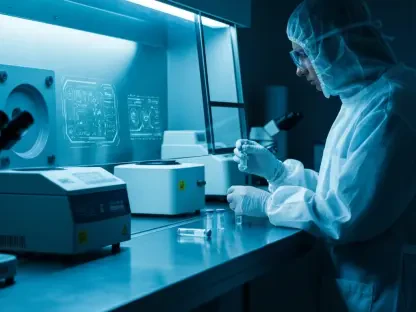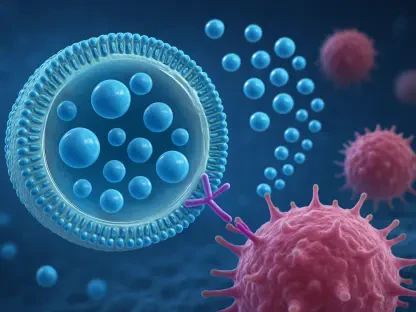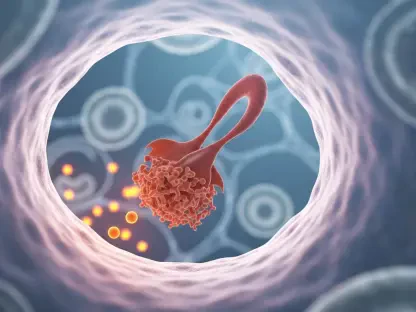Imagine a future where life-saving medications and sustainable agricultural chemicals can be produced without the unpredictability and inefficiencies tied to living cells, a vision that is rapidly becoming reality through the innovative field of cell-free biomanufacturing. This transformative approach sidesteps the inherent complexities of cellular systems, offering a streamlined method to synthesize high-value biochemicals with unprecedented precision. Leading this charge is Steve Abel, an associate professor at the University of Tennessee, Knoxville, whose pioneering research is setting new benchmarks in how industries approach production challenges. Supported by substantial funding from the National Science Foundation (NSF) through the CFIRE initiative, Abel’s work promises to reshape sectors like pharmaceuticals and agriculture by addressing long-standing inefficiencies. This article explores the groundbreaking strides being made in cell-free systems, delving into the core of Abel’s contributions and the collaborative efforts driving this scientific revolution.
Unlocking Efficiency with Cell-Free Technology
Cell-free biomanufacturing stands as a revolutionary alternative to traditional methods, eliminating the reliance on living cells that often divert energy to survival rather than product creation. By focusing on isolated biological processes, this technology enables scientists to directly manipulate reactions, ensuring that the synthesis of desired molecules takes center stage. The result is a cleaner, more efficient process where target compounds can be extracted without navigating the clutter of cellular byproducts. Abel’s research harnesses this potential, providing a clearer window into molecular dynamics and paving the way for advancements that could redefine industrial standards. This approach not only enhances output but also reduces the time and resources typically wasted in conventional setups, marking a significant leap forward for fields dependent on biochemical production.
Beyond the immediate benefits of efficiency, the implications of cell-free systems extend into broader innovation. With over a decade of expertise in computational modeling, Abel has developed sophisticated methods to predict and optimize molecular interactions at a fundamental level. This theoretical foundation allows for the design of production pathways that are not only more effective but also adaptable to a variety of applications, from crafting new drugs to formulating agricultural solutions. Such precision addresses critical bottlenecks faced by industries, where the demand for high-value products continues to grow. By stripping away the unpredictability of living systems, this technology offers a controlled environment that could accelerate the development of solutions to pressing global needs, highlighting its transformative potential across multiple sectors.
The Power of Collaborative Research
The scale of innovation required in cell-free biomanufacturing necessitates a collective approach, and Abel’s participation in the NSF’s CFIRE initiative exemplifies how teamwork fuels progress. As one of 37 experts chosen for this ambitious program, Abel contributes to two major projects backed by significant investments of $7.6 million, led by the University of California, Irvine, and $9.2 million, led by Georgia Institute of Technology. These partnerships bring together a wealth of knowledge from diverse fields, creating a synergy that amplifies the impact of their research. Such collaboration is vital for tackling the intricate challenges inherent in redefining production methodologies, ensuring that varied perspectives inform every stage of development. This model of cooperation sets a precedent for how complex scientific endeavors can achieve breakthroughs through shared expertise.
Collaboration in this context goes beyond mere resource pooling; it fosters an environment where ideas evolve through interdisciplinary dialogue. Abel has noted the centrality of working with peers to his scientific philosophy, reflecting a broader trend in the research community where cross-institutional efforts are increasingly recognized as indispensable. The combined strengths of academic institutions involved in these projects enable rapid iteration and refinement of cell-free technologies, pushing the boundaries of what can be achieved. This collaborative framework not only accelerates innovation but also ensures that solutions are robust and applicable to real-world scenarios. As industries face mounting pressure to deliver sustainable and efficient production methods, such united efforts underscore the importance of collective problem-solving in driving meaningful change.
Innovative Projects Shaping the Future
Among the standout initiatives in Abel’s portfolio is a project led by the University of California, Irvine, which explores the concept of liquid-liquid phase coexistence to enhance biomanufacturing processes. This technique, comparable to the separation of oil and vinegar, creates distinct microenvironments within a single bioreactor to optimize specific enzymatic reactions. Collaborators employ synthetic polymers to stabilize these phases, ensuring ideal conditions for synthesizing precursor molecules essential for pharmaceuticals and agrichemicals. With $1.7 million in funding over three years, this project demonstrates tangible applications, addressing the challenge of producing complex compounds that are often unattainable through traditional means. The focus on creating specialized reaction zones within a unified system represents a bold step toward more efficient and targeted production strategies.
Another groundbreaking effort, led by Georgia Institute of Technology, centers on designing modular metabolic reaction networks for cell-free production. This initiative develops eight adaptable units that facilitate critical processes like transcription and translation outside the constraints of living cells, bypassing their energy-intensive limitations. These modules can be combined in various configurations to construct tailored production pathways, offering unparalleled flexibility and scalability. The complexity of managing reaction systems with thousands of molecular structures in a single reactor is met with advanced computational modeling, allowing Abel’s team to simulate interactions and refine outcomes. This data-driven approach transforms potential obstacles into opportunities, optimizing yields and setting a new standard for how biochemicals can be produced with precision and efficiency.
Broader Implications and Future Directions
The advancements in cell-free biomanufacturing signal a shift toward more sustainable and adaptable industrial practices, particularly in sectors grappling with the inefficiencies of traditional methods. Abel’s research aligns with a growing consensus that such systems offer a viable path to meeting the escalating demand for high-value compounds, from life-saving medications to eco-friendly agricultural inputs. By integrating computational tools with experimental data, these innovations streamline complex processes, focusing on critical components while minimizing waste. This trend toward data-driven science not only enhances productivity but also reduces costs, making it feasible to scale solutions for widespread adoption. The potential to revolutionize how industries operate underscores the far-reaching impact of these developments on global challenges.
Looking ahead, the trajectory of cell-free biomanufacturing suggests a future where production is not only more efficient but also more responsive to specific needs. The collaborative nature of projects under the CFIRE initiative highlights how interdisciplinary efforts can address multifaceted issues, setting a blueprint for future research endeavors. As funding and interest in this field continue to grow, the emphasis on refining reaction networks and optimizing reactor environments will likely yield even more sophisticated applications. Industries stand to benefit from tailored solutions that can be rapidly deployed to meet emerging demands, ensuring resilience in the face of evolving challenges. This momentum points to a landscape where cell-free systems become a cornerstone of biomanufacturing, driving innovation and sustainability in equal measure.
Reflecting on a Path Forward
Reflecting on the strides made in cell-free biomanufacturing, it’s clear that Steve Abel and his collaborators have laid a robust foundation for transforming industrial production through their work with the NSF’s CFIRE initiative. Their projects tackle inefficiencies head-on, introducing novel techniques like liquid-liquid phase coexistence and modular reaction networks that redefine efficiency standards. Supported by computational modeling, these efforts illuminate the intricacies of molecular interactions, optimizing outcomes in ways previously unimaginable. The collaborative spirit that underpins this research proves instrumental, merging diverse expertise to create solutions with lasting impact. Moving forward, the focus should shift to scaling these innovations, ensuring they transition from lab to industry with seamless integration. Stakeholders must prioritize investment in infrastructure and training to support widespread adoption, while continued research should explore uncharted applications, solidifying cell-free systems as a pillar of sustainable production.









